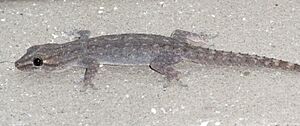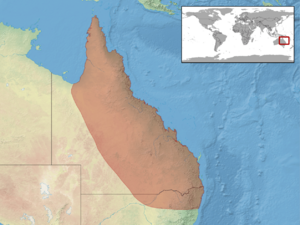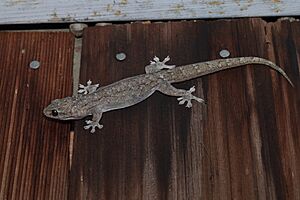Dubious dtella facts for kids
Quick facts for kids Dubious dtella |
|
|---|---|
 |
|
| Conservation status | |
| Scientific classification | |
 |
The dubious dtella is a small gecko found in Australia. It is also known as the native Australian house gecko or dubious four-clawed gecko. Its scientific name is Gehyra dubia. This gecko lives in Northeastern Australia, including Queensland and northern New South Wales. You can also find it on islands of the Great Barrier Reef and the Torres Strait.
These lizards live in many places. They like acacia and eucalyptus forests. They also live in places where humans live, like on house walls in cities. Because they are often seen in towns, people in Queensland call them common house geckos. Sometimes, people confuse them with the Asian common house gecko. That gecko came to Australia from Indonesia. However, the G. dubia has round feet and makes quieter sounds.
What Does the Dubious Dtella Look Like?
The Gehyra dubia is a small gecko. Its body, from its nose to the base of its tail, is about 6 cm long. Its tail can be up to 14 cm long. Males and females are about the same size.
When they are resting, these geckos are usually a dull gray-brown color. They have dark spots all over their back. They can change their color a little to blend in, often becoming a lighter brown. When they are looking for food, the spots on their back disappear.
These geckos have four legs, each with five toes. On each toe, there is a round pad. These pads help them stick to surfaces. This is why they can live well in human houses. They can grip onto ceilings and glass windows. Interestingly, G. dubia does not have a claw on its inner toes.
The gecko's skin, even on its tail, is smooth. This helps tell Gehyra dubia apart from other Australian gecko species. Like most geckos, they do not have eyelids. They have vertical eyes. To clean their eyes, they lick them with their tongues instead of blinking. Their large eyes are amazing at night. They are about 350 times better at seeing in the dark than human eyes.
If a predator chases a dubious dtella, it can drop its tail. This helps it pretend to be hurt and escape. The tail will grow back later.
Where Do Dubious Dtellas Live?
In the 1800s, G. dubia lived in many places. These included Southeast Asia, Pacific Islands, and northern Australia. Now, G. dubia is mostly found across Eastern Australia.
Some reports say they are on islands north of Australia and in New Guinea. This is because they are often confused with other geckos. However, experts believe their true home is only Australia.
How Do Dubious Dtellas Live?
What Habitats Do Dubious Dtellas Prefer?
The dubious dtella can live in many different places. It is very adaptable. It can be found in woodlands, dry forests, and shrublands. However, they mostly live in trees and prefer dry areas. Because of this, you won't find many G. dubia in rainforests.
Their ability to live in many places helps explain why they are common in Queensland homes. Houses offer them safe places to hide from predators. They also provide more access to food. This is why you often see them at night on walls, floors, or windows. They also like to search for scattered prey in the Australian bush at night.
What Do Dubious Dtellas Eat?
Native house geckos are active at night. So, they mostly hunt and eat when it's dark. Even though G. dubia can live in many habitats, they are picky eaters. Their diet is mainly made up of invertebrates. They prefer larger invertebrates like scorpions, spiders, and beetles.
When scientists looked at the stomachs of G. dubia, they found cockroaches or spiders. These insects stay in the stomach longer before being digested. Many night insects gather around lights in human homes. This might explain why these geckos are common in houses. They also like dark, dry spots. This explains why they are often found in dimly lit corners of houses at night.
G. dubia also eats plant nectar and sap. Sap is a quick and easy source of sugar and nutrients. These tree-dwelling animals spend a lot of time licking sap from Acacia trees. What they eat does not change much between males and females.
Dubious Dtella Behavior
How Do Dubious Dtellas Act Towards Others?
When there are many geckos around, G. dubia can become aggressive. This is because they protect their territory. If another gecko enters their space, native geckos will bite, chase, and claw to defend their home. Male dtellas show this behavior often, no matter what kind of gecko the intruder is.
G. dubia is also more aggressive when defending its home compared to other gecko species. The more aggressive an intruder is, the more aggressive the male G. dubia becomes. G. dubia is also unlikely to share a hiding spot with an intruder.
When they are stressed or aggressive, G. dubia makes loud chirping sounds. Sometimes, these sounds are too high-pitched for humans to hear. These geckos change their calls depending on the situation. Calls are a very important way for them to communicate. They use different calls for fighting and for mating. They also change their calls based on the sex and size of the gecko they are talking to.
How Do Dubious Dtellas Stay Warm?
Australian house geckos use special ways to stay warm at night. These methods are used more often in the dry season when temperatures are lower. You can often see them warming up close to trees. Trees can hold heat during cool nights.
Warm places, called thermal niches, are rare and valuable. Like food, they are important resources. Thermal niches include warm rocks, houses, and trees. Because of climate change, these lizards are changing when they are active. They do this to avoid getting too hot during the day and to stay warm at night.
Who Are the Predators of Dubious Dtellas?
Snakes often hunt house geckos. Local snakes like the Death Adder, brown tree snake, Collette's snake, and spotted python often eat G. dubia. In response, the geckos have ways to avoid being eaten.
Dtellas are good at sensing danger. They only avoid predators when they really need to. This helps them save energy. Unlike the Asian House Gecko, the native House Gecko uses its excellent eyesight to spot and avoid predators. It does not rely mostly on smell.
When faced with danger, dtellas can drop their tail at a special break point. The tail will grow back later. However, the new tail will always be a different color. Birds also eat geckos, especially when they are resting and warming up in the mornings.
Dubious Dtella Life Cycle
How Do Dubious Dtellas Reproduce?
G. dubia are oviparous. This means they lay eggs. A female usually lays two eggs at a time. The size of the eggs gets bigger as the mother gecko gets bigger.
Since G. dubia often live in human houses, they usually lay their two eggs in cracks or small spaces where they live. G. dubia lays its eggs and breeds during the wet season. Males make mating chirps during breeding season. These chirps are used to attract females.
What Threats Do Dubious Dtellas Face?
Competition with Asian House Geckos
Asian House Geckos (Hemidactylus frenatus) are an invasive species. They were brought to the Northern Territory and Queensland by accident in the 1960s. Since then, they have been very successful because they can live in many different places.
The Asian House Gecko and native geckos like G. dubia often live in the same types of places. This causes them to compete directly. Like G. dubia, H. frenatus thrives in human houses because there is plenty of food. H. frenatus is also more comfortable with light than G. dubia. This gives the invasive species an advantage in houses. It allows them to get more food than G. dubia.
Many scientists believe that H. frenatus has been pushing G. dubia out of houses. They think G. dubia are being forced back into natural areas like forests and rocky spots. However, G. dubia seems to do better in natural Australian habitats than H. frenatus. The Asian House Geckos have not spread much into wild areas.
Scientists are also worried about the tiny living things (microbiome) that H. frenatus carries. Parasites that live on H. frenatus could harm G. dubia as they meet more often.
Also, G. dubia is known to be more aggressive than H. frenatus. Asian House Geckos often try to run away or show their tails when threatened. But Dtellas will bite and scratch other geckos. Asian House Geckos also show more anti-predator behavior. This is likely because they are new to the area. G. dubia has faced similar predators for a long time. So, they are better at defending themselves. H. frenatus has not been in Australia long enough to adapt. All these things help H. frenatus do well in cities but struggle in the wild.
Relationship with Humans
Since they are often found in houses and cities, many Australians see G. dubia. Because they live in many places and are common in homes, some people see them as pests. People often hear them scurrying around houses at night. They can knock over things or even accidentally damage electrical wires. For these reasons, many are killed each year because they are seen as a bother. However, they do help control insect and spider populations, which is a good thing that often goes unnoticed.
Their similarity to H. frenatus causes many people to confuse the two. This can lead to people thinking G. dubia is also an invasive species that needs to be removed. But in reality, they are native to Northeastern Australia.
Conservation Status
The IUCN Red List lists G. dubia as Least Concern. This is probably because they can live in many different places. Their ability to do well in cities has helped their population size stay steady.



